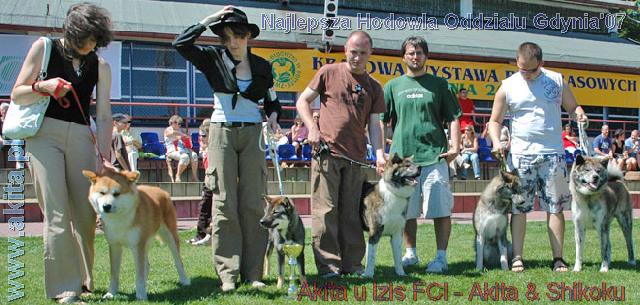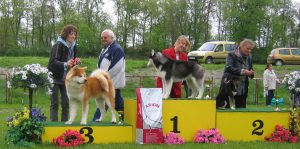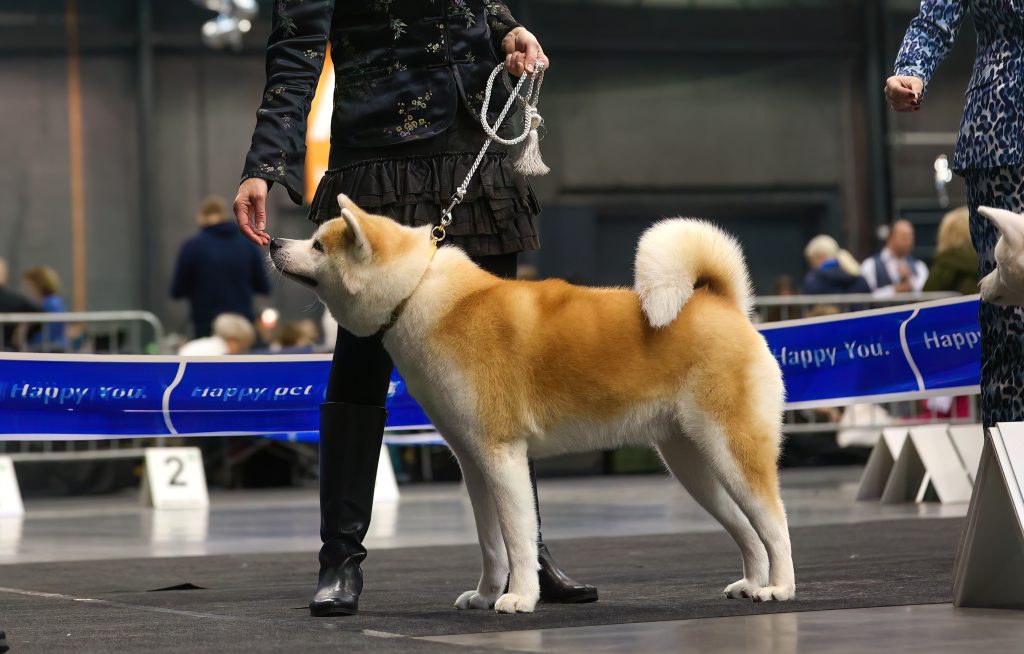 One of the attractions of an Akita owner are exhibitions, where you can show your dog to a Kennel Club judge and establish contacts with other breeders and owners. At exhibitions, our Akita can receive not only breeding grades but also titles if we have a model copy of this breed. However, above all, we should treat it as good fun and a nice way to spend the weekend, and remember that the dog will not get angry even after receiving a worse mark. Sometimes our dog may simply be having a bad day (he may also be annoyed by the echoes at exhibitions organized in halls), and judges are only human too. So it's good not to get discouraged after the first unsuccessful exhibition. Just treat it as the proverbial "first cats for the fences".
One of the attractions of an Akita owner are exhibitions, where you can show your dog to a Kennel Club judge and establish contacts with other breeders and owners. At exhibitions, our Akita can receive not only breeding grades but also titles if we have a model copy of this breed. However, above all, we should treat it as good fun and a nice way to spend the weekend, and remember that the dog will not get angry even after receiving a worse mark. Sometimes our dog may simply be having a bad day (he may also be annoyed by the echoes at exhibitions organized in halls), and judges are only human too. So it's good not to get discouraged after the first unsuccessful exhibition. Just treat it as the proverbial "first cats for the fences".
You must register your Akita for exhibitions in advance: for international or club exhibitions, even two months in advance, and for national exhibitions, one month. Remember to specify the gender of your Akita, as males and females start separately. We report him to the appropriate class due to his age. The age that determines which class our pet will compete in is its age 1 day before the exhibition, not its age at the time of completing the application. And so we have been entering him in the puppy class for 6-9 months. Between 9-18 months to the youth class, but from the 15th month we can also choose between the intermediate class (up to 24 months) or even the open class - but it should be taken into account whether the dog is already developed enough to be able to compete with adults dogs. If we are registering for the champion class, we must attach a photocopy of the championship, and if we want the title Polish Junior Champion to be printed in the catalog (this title alone does not entitle us to start in the champion class - except for the champion exhibition - and only for a year), we also need a photocopy of this document. There is a veteran class for dogs over 8 years old that are not champions.
Currently, it is also required to attach a photocopy of our dog's pedigree to each application. However, if it is still in preparation, enter the registration number assigned to it when submitting the certificate to the Kennel Club.
We accustom the Akita to brushing and grooming (e.g. trimming its nails) from the time it is a puppy. Brushing him gives him pleasure (as long as we remember not to pull him violently), and it even deepens his bond with his owner. After all, in a pack, grooming each other's fur is the greatest sign of attachment, so the puppy sometimes tries to "comb" us gently with its teeth. For your toddler to like combing his hair, we must slowly teach him to trust us. We start with the back and sides, then brushing the paws, belly and throat. Be patient and consistent – don't force it! We start by combing the dog against the grain, and when he gets used to it, we can comb against the grain. We brush carefully so as not to scratch the puppy's sensitive skin and discourage it in the future. If the brush is not made of bristles, but made of metal, it should be equipped with protective plastic balls at the ends of each wire (brushes with curved spikes, which will make it easier to brush out dead hair, should also have such ends).
If the puppy runs away when it sees the brush, we catch it and give it a tasty reward to convince it to let itself be brushed. If we are consistent, the Akita will assume that you will do your job anyway, and since there is no threat and they give you a reward, it may be worth agreeing to such treatments.
A treat is also a good idea when trimming the nails. When trimming them, be very careful not to cut too much and hurt your baby. The claws should be of such a length that when the puppy stands on a flat floor, the claws do not touch the floor.
Also, before the exhibition, the Akita's claws should be trimmed (not forgetting the fifth ones on the front paws), because too long claws may result in the judge writing down the dog's "loose fingers" in the dog's evaluation form, and this is not a plus. It would also be a good idea to clean his ears and teeth, although tartar usually accumulates on the teeth of smaller breeds and Akitas - as long as they crunch their bones from time to time - should not have this problem.
Contrary to appearances, the beautiful fur of the Akita does not usually require excessive care. This hair does not hold dirt or absorb moisture, and has the ability to self-clean. Even the mudiest Akita, after drying and shaking off the remnants of mud, is clean again... all we need to do is vacuum the apartment, because sand will obviously end up on the floor. However, before the exhibition, it would be a good idea to bathe the Akita and prepare it so that it dazzles the audience and the judge with its lush, extremely impressive hair.
Bathing is a difficult experience for every Akita. Suddenly the dog lands in the bathtub, its paws scatter on the slippery surface, the rumbling sound irritates the ears and the water makes so much noise as it falls. Even those Akitas that like water and willingly swim in natural reservoirs do not have to like such a bath. To make it easier for your toddler to adapt to this new situation, let's start dry training. Place the puppy in a bathtub lined with a towel or, preferably, a special anti-slip bathtub mat available on the market. Reward him with a treat, then wet him slightly with water, and then pour the water in, making sure it is neither too cold nor too hot. Our akitka should gradually get used to bathing, but let's not delude ourselves that she will like it... because it will be a success when she can bathe calmly. How often after such baths the owner is wetter than his dog. After washing thoroughly with a shampoo suitable for puppies - taking care not to let water get into the ears or the shampoo into the eyes (as this would further discourage the baby from bathing) - do not forget to rinse it very thoroughly and then dry it almost dry with a towel. We should familiarize the little Akita with the dryer as early as possible, but also gradually. If you are familiar with this equipment, you brush and dry it at the same time, which is very time-consuming, but it prevents the hair from bending and remains straight, which will give the dog an even more impressive and eye-catching look, which is worth paying attention to, especially before an exhibition.
Please remember to use only proven shampoos before the exhibition and not to experiment with new ones that may cause allergies to your pet. A dog that scratches constantly at an exhibition will lose a lot of its elegance. In order to dry the entire Akita and not break the hair, you would need a special dryer that can withstand several hours of drying. It is worth looking for a dog grooming salon with a large, powerful dryer on a stand, because drying the entire Akita with a hand dryer so that it does not bend its hair is a job worthy of Hercules! However, if we have no other choice, we comb and dry it in sections - first the head, then one side, then the other, etc.
If our Akita shakes its ears, scratches them or wears one or both of them differently, it may be a sign that it has developed an ear infection, which is often a consequence of even a small amount of water getting inside the ear during bathing. Therefore, always carefully check the Akita's ears to see if even a bit of water has got into them. Ear inflammations tend to recur frequently, so let's take special care of them.
It is easy to hide minor defects of a dog's structure in its lush fur, but an experienced judge will not stop at just looking at the dog, but will carefully check its structure by touching it. If our dog has minor problems with the backline, this can be corrected by removing an appropriate amount of undercoat in the parts that are excessively curved upwards and by slightly upholstering the hair in places where the backline should be slightly higher. Some people fix the backcombed hair with hairspray or styling foam, which leaves no traces after drying (unfortunately, you won't get the expected results when it's humid outside) - but be careful - it sometimes happens that our Akita may be allergic to this type of cosmetics! After bathing, it is a good idea to use "Volumizer" by Jean-Pierre Hery or another preparation that increases hair volume.
Troublesome for Akitas, as for most Spitz dogs, is visible and sudden shedding of hair once or even twice a year, but in female dogs it is generally related to heat, and in dogs it is only related to the season. Therefore, it is often difficult to plan exhibitions - especially for female dogs. It often happens that whenever a female dog is entered for an exhibition (and, as we know, the registration must be done quite well in advance), she is either bald or is in heat. And as we know, according to exhibition regulations, a bitch in heat cannot be exhibited, because it would prevent the dogs from presenting themselves properly and they would lose all interest in everything else except the bitch. It is worth marking in the calendar when your dog was in heat and writing down the next ones so that you can plan exhibitions for times when she is not in heat.
Akita owners know what a problem it can be to prepare it for an exhibition when a beautifully prepared pet suddenly starts shedding handfuls of hair just before the exhibition and its appearance reminds us of a massive attack of moths. In this condition, it would probably not impress the judge, so it is better to refrain from showing it and wait until it grows again.
Sometimes, if we are planning an exhibition and our dog has not shed its hair yet, it is better not to bathe it, as it speeds up the hair replacement, and only dry clean it. For this purpose, you can use potato flour or special dry shampoos (e.g. "Bea" by Beaphar or "Dry-Bath" by Bio-Groom), which can be purchased in most pet stores. We pour this preparation onto the dog, wait the time specified on the package, and then brush the dog carefully. If we do it imprecisely, the hair will fall off after a short time and we will not achieve the expected effect. However, he should be bathed normally then and after the exhibition.
White Akitas require the use of a specialized shampoo for white dogs because their hair, especially in summer, tends to turn yellow under the influence of the sun. Sometimes they are also prone to unsightly dark marks from the inner corners of the eyes. You can wipe them with a cotton pad soaked in "Diamond Eye" eye cleaning liquid, which does not stain. Chamomile extract should be avoided as it will permanently stain the Akita.
We show the Akita without having to position it with our hands, in a free, natural and as easy way as possible. Let's try to avoid correcting the paws in the ring or positioning the dog as is done with dogs from other groups, unless the dog is used to it and tolerates it well. If it stands incorrectly, let's move a little forward or make a small circle and set it again. Some dogs exhibit beautifully for a prize (just don't lose the prize in the ring, it may distract another dog and it will be frowned upon by other exhibitors). Others have no interest in eating in the ring at all – especially if they are stressed.
Sometimes you need to hold the Akita's tail, because if it is hot, the dog has been waiting for a long time and is tired, it may drop its tail while standing. However, when running, each Akita must have a tail on its back.
The exhibitor must be able to run the dog around the ring - not necessarily just one circle. You need to pay particular attention to your running pace and the appropriate length of your steps. The pace must be such that the dog looks as good as possible.
It is best to present the Akita on the so-called ring collar, white on white, fawn on fawn, etc. We match the color of the ring collar to the color of the dog. It's best to buy ringfish at an exhibition, because that's where the largest selection is. Displaying on spike strips is unacceptable. The dog will not look as it should on a regular collar. If someone can afford it, they can buy an original Japanese ring dog... but its price exceeds the price of a good dog, so it's probably not a solution for everyone. The exhibitor should wear trousers that contrast with the color of the dog. He should be dressed elegantly and have his starting number stuck in a visible place (usually the left shoulder or left side of the chest).
Unfortunately, Akitas do not tolerate heat very well, so before the exhibition season, it is worth buying a beach tent, a beach tent or at least an umbrella under which your pet will be able to escape from the sun. There may also be a cage, covered with an airy and, if possible, slightly dampened material to provide shade and slight coolness. Classic tents are not suitable because the air inside them simply boils and the dog may be worse in them than outside. Remember to take a bowl and water for your dog, and also food for longer trips.
Sometimes (although not very often) the wait for our turn to enter the ring can be long, and an Akita exposed to sunlight may suffer a stroke. Therefore, you should arrive at the exhibition early enough to collect the exhibition catalog, find a suitable ring and settle in. If we have not paid in advance and we intend to pay only at the exhibition, unfortunately, in addition to paying more, we will also have to stand in a long queue to the ticket office and to collect our starting number, and sometimes also a briefcase. And we would be sad if, while we were furiously stuck in the queue, an Akita judging took place in our ring... but without our dog. Moreover, even if by some miracle we manage to make it on time, we will be nervous and this will unfortunately affect our dog. So it's better to pay together with the application and get the number home. The final corrections, such as combing the ruff or tail, can be made just before entering the ring.
Akitas may drool excessively when hot, so it's worth having something to wipe your dog's face with. It is worth taking a paper towel with you to clean your pet when it rains and you have to wade through puddles and mud to get to the ring. After such a journey, the Akita no longer resembles the one we took from home.
Before presenting our favorite at an exhibition, we need to practice with it a bit. We start practicing the standing exhibition position with a tiny puppy, and you can also use a treat for this purpose, which will be a reward for persistently standing still in a usually mobile baby.
With a slightly older dog, we can also start practicing walking on the left side, then further training in putting him in a show position and presenting his teeth (here we need the help of friends and neighbors who will pretend to be a judge and look at the teeth), and in the case of a male dog, you should also remember that the judge will not only want to check his teeth or structure, but also his testicles. So you need to accustom your dog to this strange exhibition habit from a puppy. When it comes to muscles, remember not to throw the baby out with the bathwater and not to overtrain a too young dog. Practically, it is only when he is about 15 months old that he can run long distances or pull a heavily loaded sleigh or stroller. Excessive load on a younger Akita may have disastrous consequences because the growing bones and young joints are still too plastic and the dog can easily be overtrained.
After entering the ring, line up in the order of your starting numbers. After seeing the entire Akita group, the judge asks for a movement presentation. You should then run in a circle (counterclockwise) with the dog at your left leg, remembering to keep the distance. When the judge asks us to present our dog in a straight line, we run in the indicated direction, at the end of the ring we turn around and run back to the judge and put our Akita in the exhibition position again. Then the judge asks each dog to come to the table, where he checks the bite (sometimes personally, sometimes using an exhibitor), the dog's conformation and, in males, also the testicles. After the description, we return to the dogs waiting for the description and line up at the end. After describing the entire group, the judge will ask once again to present all the dogs (or only the dogs selected by him) in motion. Let us remember that the Akita is assessed throughout its stay in the ring, so it should look as good as possible while it is in the ring. After the evaluation, the judge awards places and hands out score cards and diplomas. The first three dogs with an excellent grade receive medals. It is good manners for the judge to justify the assessment. There should be no comment on the verdict. The judge's assessment - although not always accurate - is unquestionable.
If our Akita has won, you should wait for the comparison: first the class winners of a given sex, then the winning male competes with the winning female for the title of Best of Breed. If our pet receives this honor, we will be asked to present the Akita in the final competitions. It's nice to run with our pet in the ring of honor, but it is not obligatory. The final competitions are organized after the evaluation of all breeds in the rings is completed, which is quite late. Some people prefer to go home. But then they won't know whether their favorite may have just missed out on the title of Group Winner or 2nd or 3rd place... and a pretty nice cup (at some exhibitions, cups are also given to breed winners - to be collected in the honorary ring after getting out of the BOG elections of a given group - therefore it is worth reading the catalog, where information about the cups is always included). Wishing you much success, I greet all those who will soon make their debut on the show rings.
And a motto for future exhibitors:
"A beautiful Akita will not get ugly when he gets a worse grade than he deserves"




 One of the attractions of an Akita owner are exhibitions, where you can show your dog to a Kennel Club judge and establish contacts with other breeders and owners. At exhibitions, our Akita can receive not only breeding grades but also titles if we have a model copy of this breed. However, above all, we should treat it as good fun and a nice way to spend the weekend, and remember that the dog will not get angry even after receiving a worse mark. Sometimes our dog may simply be having a bad day (he may also be annoyed by the echoes at exhibitions organized in halls), and judges are only human too. So it's good not to get discouraged after the first unsuccessful exhibition. Just treat it as the proverbial "first cats for the fences".
One of the attractions of an Akita owner are exhibitions, where you can show your dog to a Kennel Club judge and establish contacts with other breeders and owners. At exhibitions, our Akita can receive not only breeding grades but also titles if we have a model copy of this breed. However, above all, we should treat it as good fun and a nice way to spend the weekend, and remember that the dog will not get angry even after receiving a worse mark. Sometimes our dog may simply be having a bad day (he may also be annoyed by the echoes at exhibitions organized in halls), and judges are only human too. So it's good not to get discouraged after the first unsuccessful exhibition. Just treat it as the proverbial "first cats for the fences".